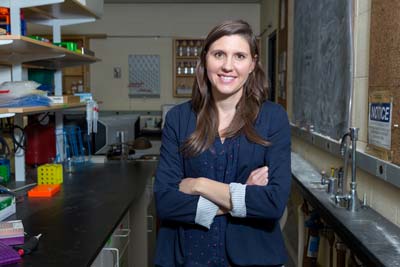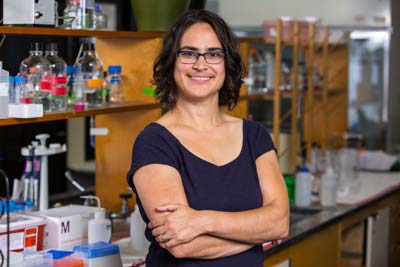July 14, 2015
By Madeline Ruoff ’18
Assistant Professor of Physics Ashley Carter and Assistant Professor of Chemistry Sheila Jaswal were recently awarded funding for research that seeks to understand how biological material folds. Carter received a Cottrell College Science Award of $40,000 for her project “Optical Trapping Assay to Study Histone Replacement During Spermiogenesis,” while Jaswal received $20,000 from the Webster Foundation for her research into the “Development of Hydrogen Exchange Mass Spectrometry Methodology to Map Protein Landscapes.”

Ashley Carter
Carter studies how DNA folds in sperm cells. Usually, a strand of DNA folds around a protein called a histone, and tags on the histone determine where the folding is more compacted. However, in sperm, 85 percent of these histones are removed and replaced with protamine to make the sperm nucleus as small as possible. Incorrect histone replacement can lead to male infertility and to changes in the folding of the genetic material that gets passed on to the next generation.
Carter’s research involves watching a strand of DNA fold and unfold to discover the pathway for histone replacement in a sperm cell. To watch it fold, she attaches a bead to a strand of DNA and images the bead in an optical microscope. As the DNA folds, the bead’s movements become smaller and smaller. She can then pull on the bead to unfold the DNA. If this process is done in the presence of histones and protamine, she can watch loops of DNA unravel as the histone is replaced.

Sheila Jaswal
Separately, Jaswal is developing a technique, called hydrogen exchange mass spectrometry, to study the folding and stability of proteins. Mass spectrometry weighs molecules, and as a protein unfolds and refolds in a solution of heavy water (deuterium), it becomes tagged and gets heavier. The rate at which the protein’s weight is changing reveals how stable the protein is. Jaswal and her students then computationally model the data collected with this technique to understand and compare different modes of protein stability.
How DNA folds is relevant in epigenetics (the way genes are expressed) because there is less genome activation in more tightly compacted areas. Additionally, misshapen or uncompacted DNA in sperm can cause infertility.
“I’m really excited about the science of how DNA mechanically folds inside a sperm cell,” says Carter. “It’s such a basic, simple question, but it has so much importance in epigenetics and infertility that I wonder why no one’s done it before.”
Jaswal’s research helps scientists understand what makes proteins stay in their proper structure, which is relevant to a number of diseases. For example, slow folding of a protein that regulates the salt balance in cells is associated with cystic fibrosis, and destabilization of another protein is involved in Huntington’s disease.
Traditional observation techniques—which involve applying high concentrations of chemicals and heat—are harsh and destabilize proteins. Jaswal’s approach instead focuses on investigating proteins under mild conditions, and therefore could be used to study the stability of a larger range of proteins and, by extension, answer myriad questions relating to protein folding. As she explained, her research lets her “take both an experimental and a computational approach to study a really interesting problem at the intersection of biology, chemistry and physics.”